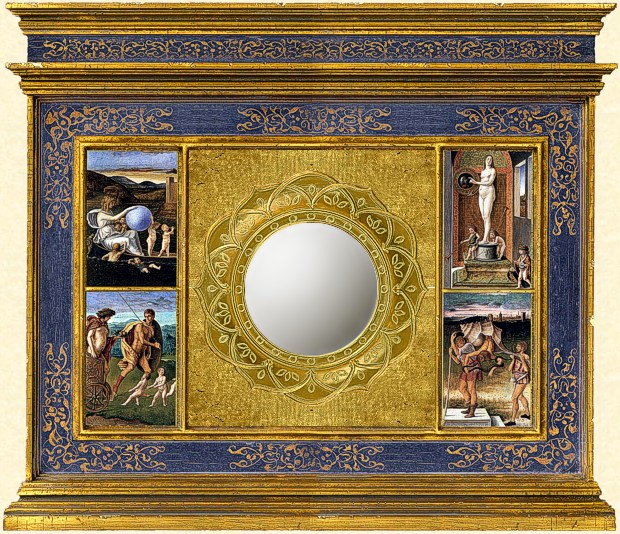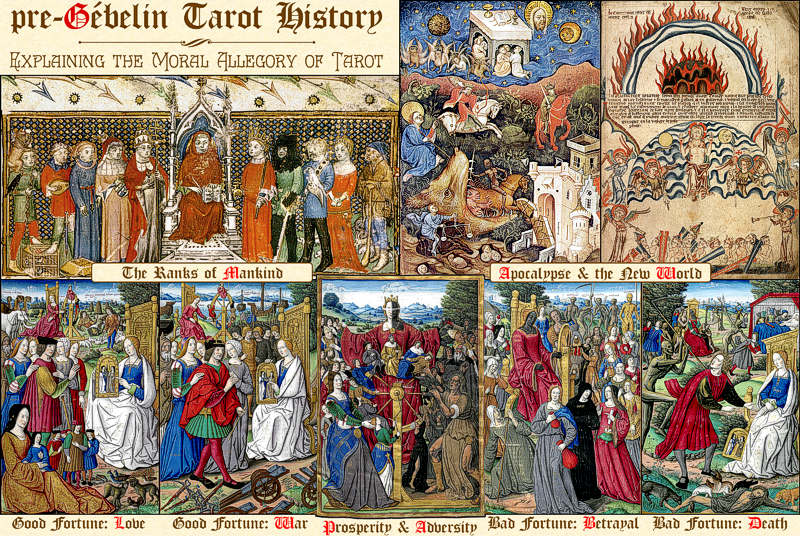A few days ago, Jean-Michel David posted a picture of one of the "Bellini Allegories" to the Tarot History Forum. The image was so bizarre that I immediately asked if it came from a series of some sort, or had some other context to explain it. It turns out that it is from a series, and that they constitute a famous iconographic puzzle. This post is just a brief introduction to the Allegories of Giovanni Bellini, (held at the Gallerie dell’Accademia Venezia, the Venice Academy), using some quotes from Giles Robertson's 1968 Giovanni Bellini.
Ludwig explained the woman in the boat as Inconstance, the nude with the mirror as Prudence, the 'Bacchus and Mars' as Perseverance, the man emerging from the shell as Calumny, and the 'Harpy' as Summa Virtus with bandaged eyes for Justice, the jugs for Temperance, the claws for Fortitude. A hypothetical sixth panel was to have represented the crowning of the 'Tugendhelder' [Virtuous Hero].
Gustav Ludwig (1852-1905) was a German-English art critic/historian. Today he is almost completely forgotten, but he was a notable figure in turn-of-the-century Italian art-history studies. Ludwig was apparently responsible for some of the earliest pronouncements on the subject matter of Bellini's allegories, and for explaining their function on a restello. Rona Goffen explains:
Restelli were luxurious secular objects, elaborate and costly mirrors enframed with carved and gilded wood, and surrounded by small paintings, the ostensible practical purpose of all this being the convenient storage (and the true purpose, the display) of toilet articles that were themselves luxurious, such as decorated combs, and to clean them, long brushes of horsehair with elegant fittings.
It was essentially a mirrored vanity, in both senses of the word. They were such a sumptuous luxury item that the were prohibited in Venice, at about the same time that Bellini is thought to have painted these Allegories. Edgar Wind proposed the following arrangement of the five paintings around a central mirror.

Wind suggests Fortuna Amoris for the woman in the boat, pairing with Vana Gloria, the nude with the mirror, the pair symbolizing woman's good fortune and her ill fame; Comes Virtutis for Bacchus paired with Servitudo Acediae, the man in the shell, the pair showing Man's good fortune and his ill fame; the whole surmounted by Nemesis, the Goddess of Chance, Retribution, and Temperance.
Various others have offered explanations as well.
Hartlaub has more recently [1942] proposed another series of identifications, but his interpretation is marred by starting off from Ludwig's faulty reconstruction. For him the woman in the boat is Vanity, the figure with the mirror Truth (showing a highly unflattering reflection), 'Bacchus and Mars' Abstemiousness, the man in the shell Illusion or False Prophecy, and the 'Harpy' Fortune, the hypothetical missing sixth panel representing Truth and Self-knowledge.
It seems that the current consensus is that only four of the five images traditionally grouped as Bellini's Allegories are actually related as a unified iconographic program. There also appears to be some agreement about their relative horizontal and vertical arrangement, (the same as that used by Wind). Using just those four paintings and the proper arrangement, grouped around a small central mirror, this gives some indication of the original layout.

Naturally the illustration above is false. This is merely an imaginary gilded frame. (The convex mirror, approx. 12" diameter with a round frame, mimics the one held by the Vanitas allegory in the top-right panel, and to a lesser extent the sphere held by the Fortuna allegory in the top-left.) However, the essential elements -- a small, round mirror, with the four paintings flanking it, set in an elaborate gilded frame -- is at least suggestive of the four images' original setting. (Given the size of the paintings, about 13.4" x 8.7", this reconstruction would be a little under five feet wide at the base.) The Web Gallery of Art has reproductions of the four paintings themselves, (listed clockwise from top-left).
Four Allegories: Fortune (or Melancholy)
http://www.wga.hu/html/b/bellini/giovanni/1490-99/137alle3.html
Four Allegories: Prudence (or Vanity)
http://www.wga.hu/html/b/bellini/giovanni/1490-99/137alle4.html
Four Allegories: Falsehood (or Wisdom)
http://www.wga.hu/html/b/bellini/giovanni/1490-99/137alle2.html
Four Allegories: Lust (or Perseverance)
http://www.wga.hu/html/b/bellini/giovanni/1490-99/137alle1.html
The Aiwaz site has significantly larger images of the four pictures. Just enter "harpy" as a search term and they come up, (although the painting with the harpy isn't included!)
Virtual Art Gallery
http://www.aiwaz.net/



I am a student at Fairmont State University. My Senior Seminar Class is compiling a website devoted to Reynard the Fox as an undergrad research project. I was wondering if you would be so kind as to let us use your Wheel of Fortune image and your little write up on the site with full credit to you of course. You can email me at egolden@students.fairmontstate.edu. My name is Liz and I love your site.
ReplyDelete